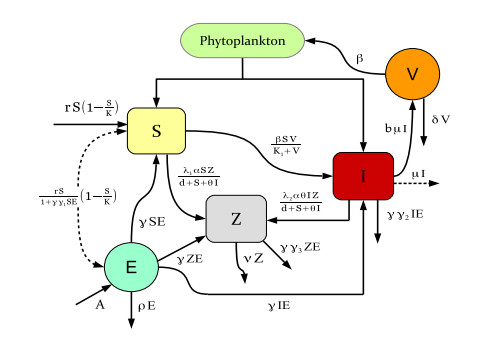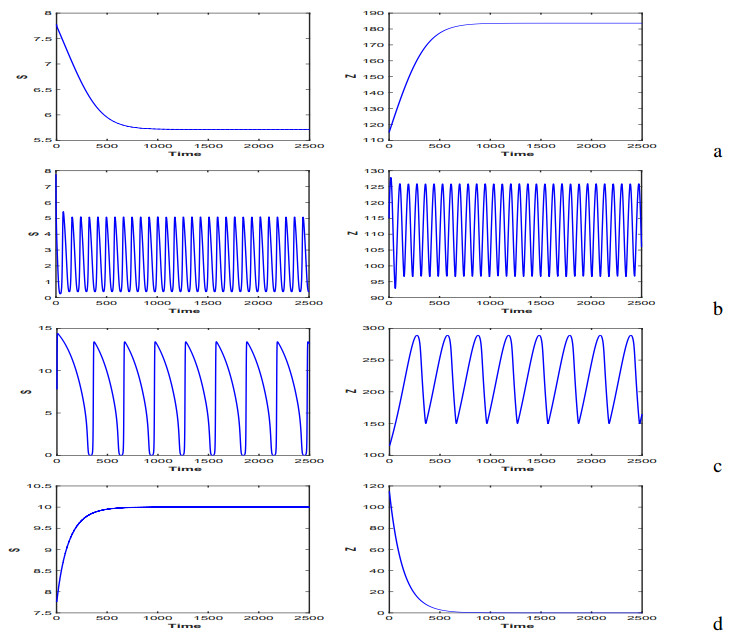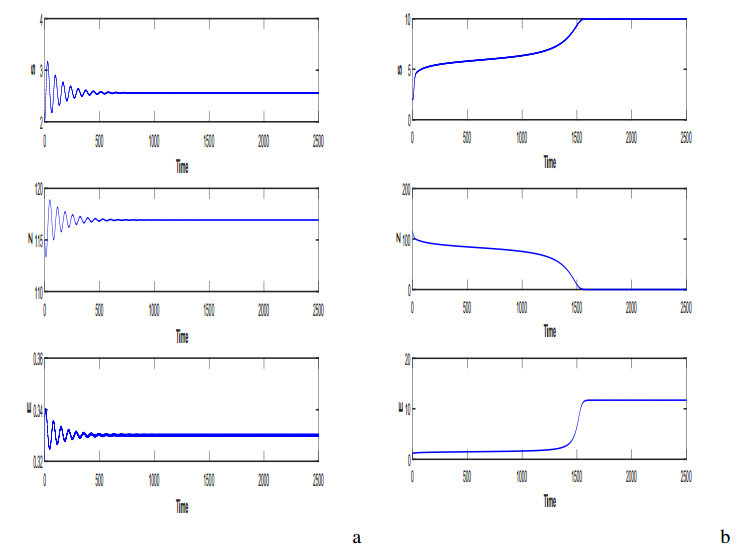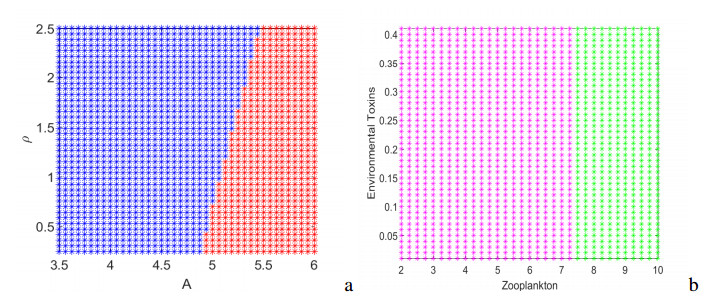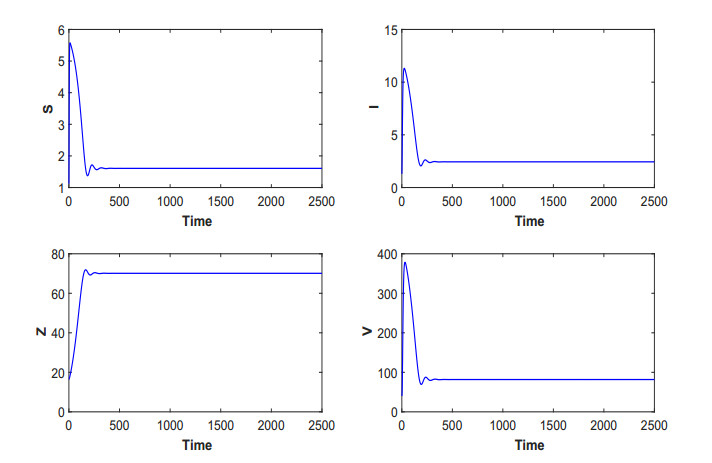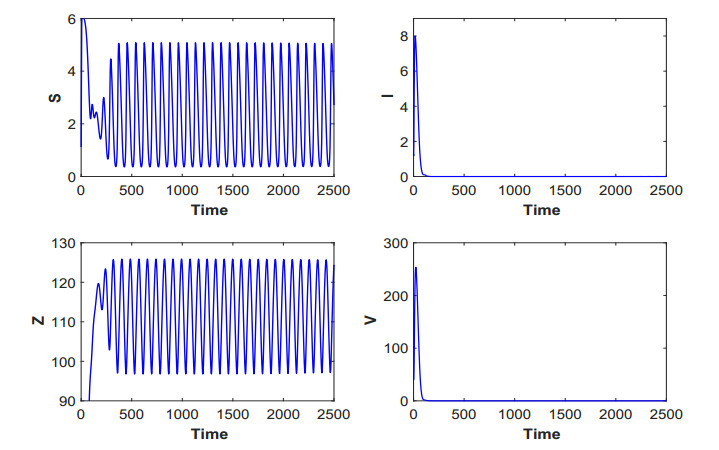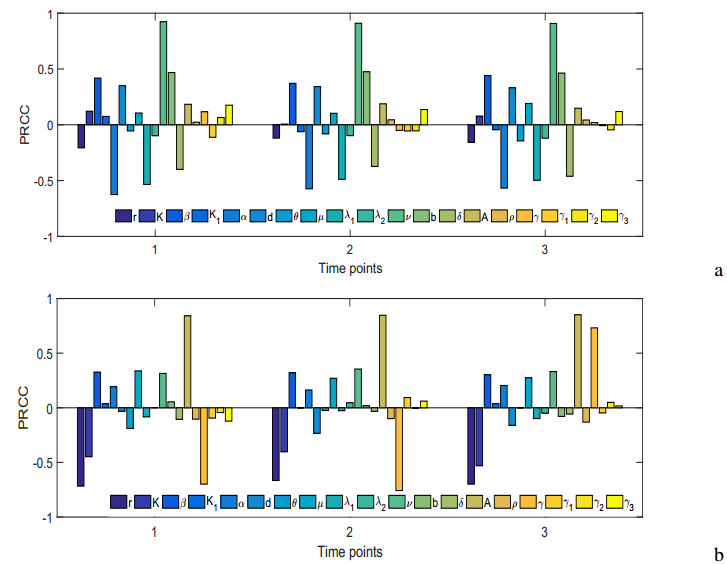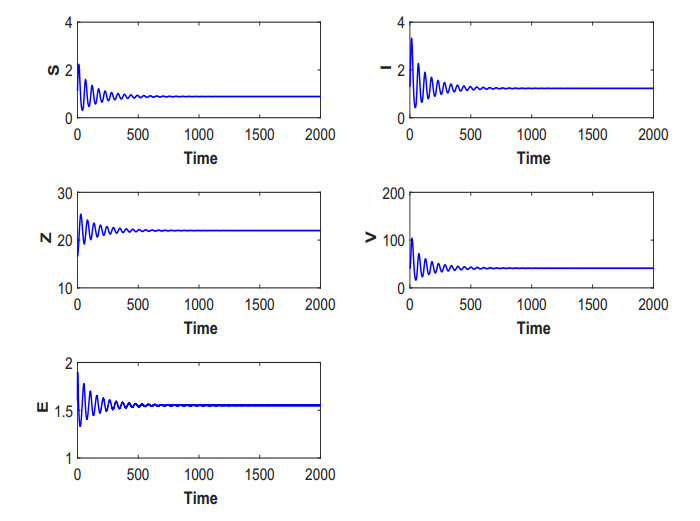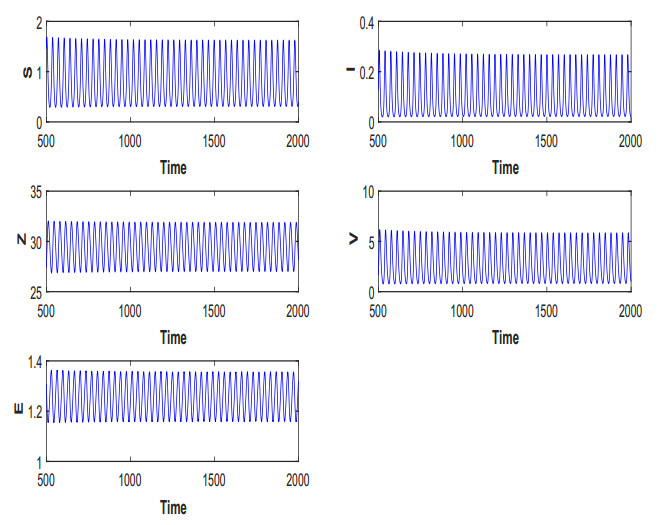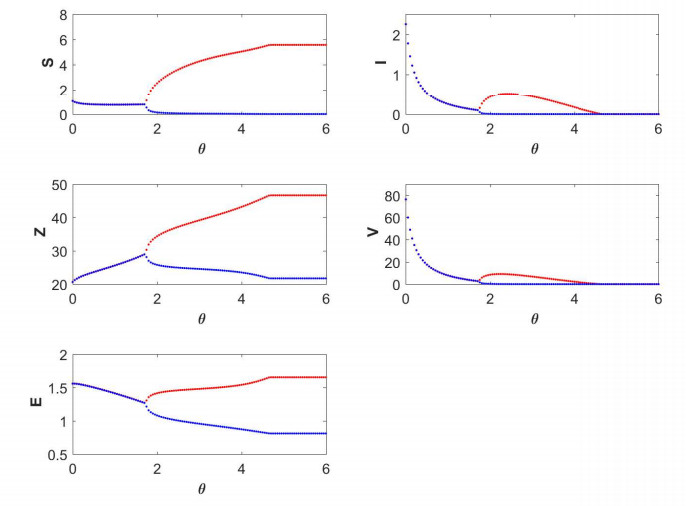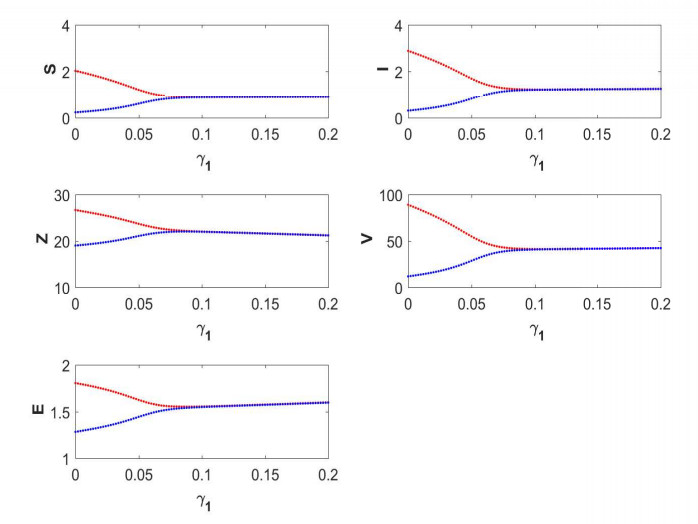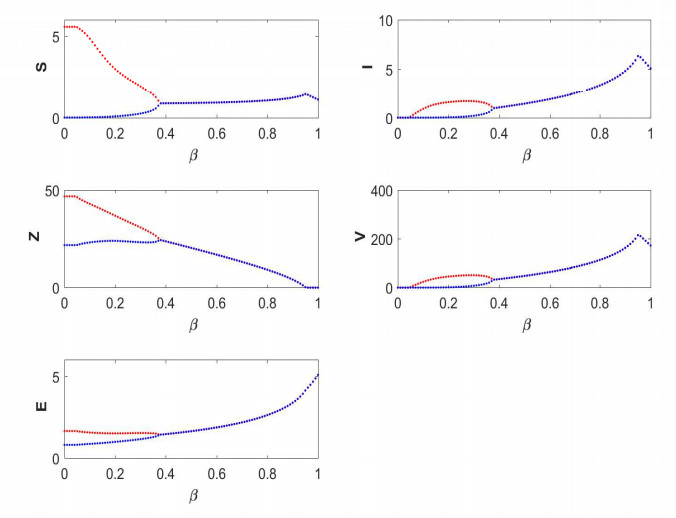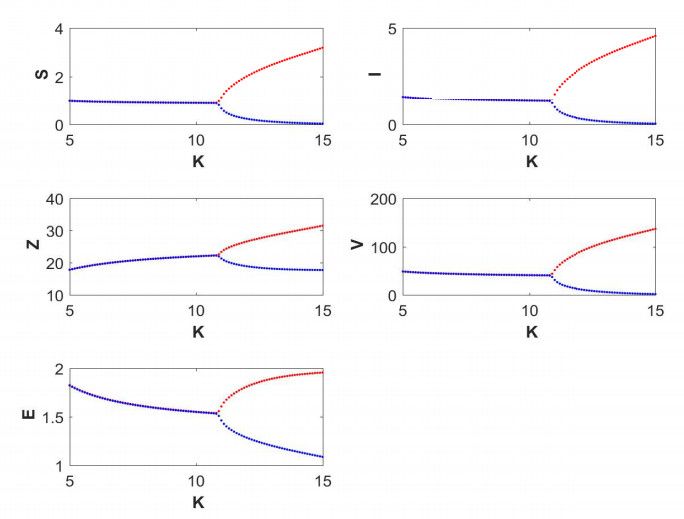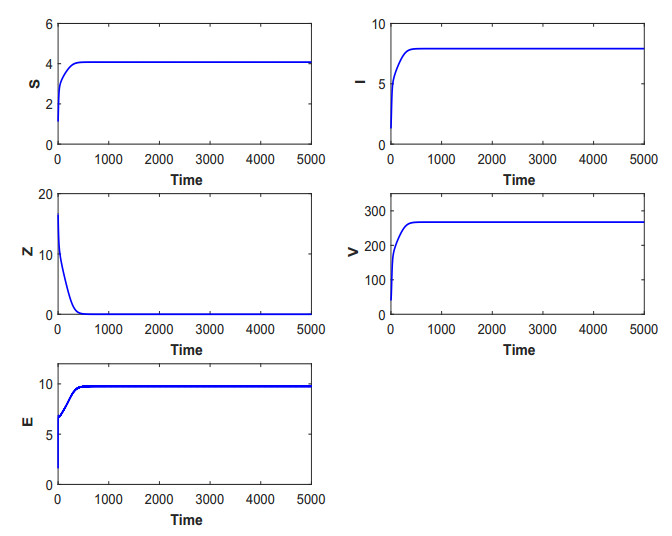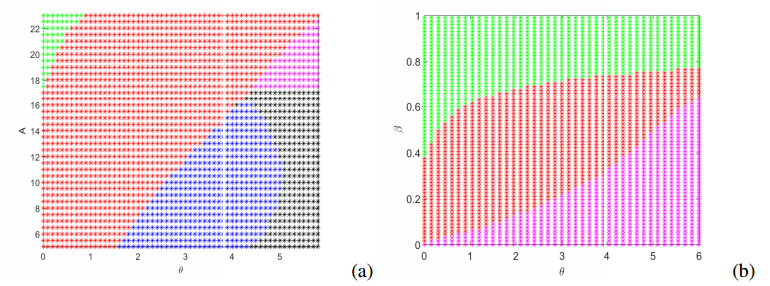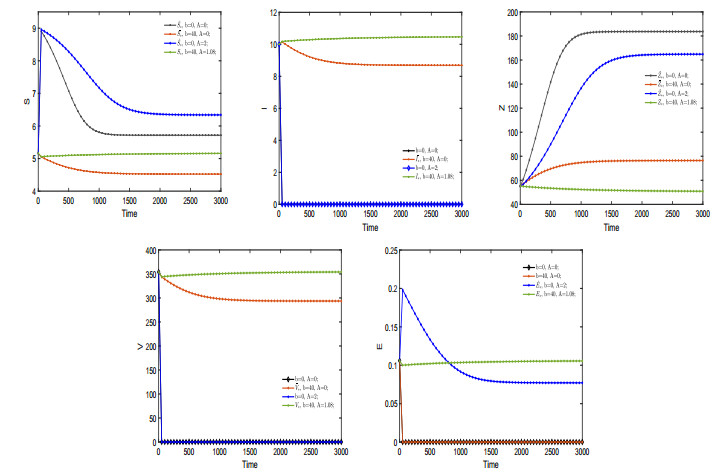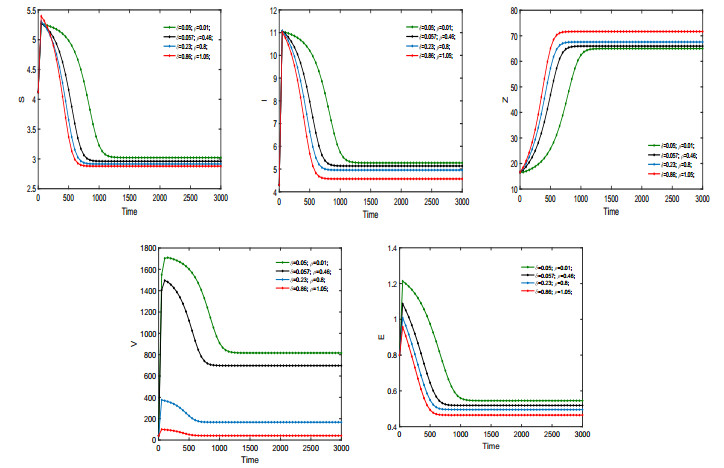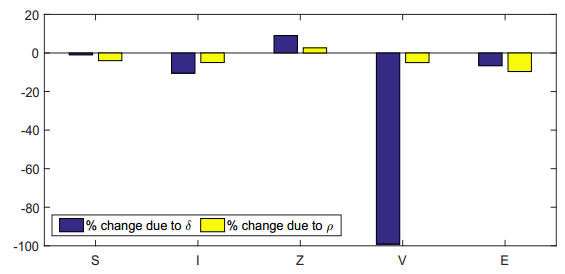In the present study, we investigate the selective feeding of zooplankton on phytoplankton infected by free-viruses in the presence of environmental toxins in the marine ecosystem. The environmental toxins assume to decrease the growth rate of susceptible phytoplankton, and increase the death rate of infected phytoplankton and zooplankton. Global sensitivity analysis identifies important parameters of the system having crucial impact on the aquatic health. The coexistence equilibrium of the system stabilizes on increasing the parameters related to inhibition of phytoplankton growth due to environmental toxins and the force of infection, and destabilizes on increasing the carrying capacity of susceptible phytoplankton and preference of zooplankton on infected phytoplankton. The chance of extinction of free-viruses increases on increasing the preference of zooplankton on infected phytoplankton or decreasing the force of infection. Moreover, if the input rate of environmental toxins is high, then the system becomes zooplankton-free for higher values of force of infection. On increasing the values of preference of zooplankton on infected phytoplankton, the system exhibits transition from stable coexistence to oscillations around coexistence equilibrium to oscillations around disease-free equilibrium. We observe that the presence of free-viruses and environmental toxins in the system drive zooplankton population to very low equilibrium values but the ecological balance of the aquatic food web can be maintained by modulating the decay (depletion) rate of free-viruses (environmental toxins).
1.
Introduction
Corrosion of concrete by acidic compounds is a problem for construction as corrosion can lead to erosion and degradation of the structural integrity of concrete structures; see e.g., [1,2]. Structural failures and collapse as a result of concrete corrosion [3,4,5] is detrimental to society as it often impacts crucial infrastructure, typically leading to high costs [6,7]. From a more positive side, these failures can be avoided with a sufficiently smart monitoring and timely repairs based on a priori calculations of the maximal lifespan of the concrete. These calculations have to take into account the heterogeneous nature of the concrete [8], the physical properties of the concrete [9], the corrosion reaction [10], and the expansion/contraction behaviour of corroded concrete mixtures, see [11,12,13]. For example, the typical length scale of the concrete heterogeneities is much smaller than the typical length scale used in concrete construction [8]. Moreover, concrete corrosion has a characteristic time that is many orders of magnitude smaller than the expected lifespan of concrete structures [10]. Hence, it is computationally expensive to use the heterogeneity length scale for detailed simulations of concrete constructions such as bridges. However, using averaging techniques in order to obtain effective properties on the typical length scale of concrete constructions, one can significantly decrease computational costs with the potential of not losing accuracy.
Tractable real-life problems usually involve a hierarchy of separated scales: from a microscale via intermediate scales to a macroscale. With averaging techniques one can obtain effective behaviours at a higher scale from the underlying lower scale. For example, Ern and Giovangigli used averaging techniques on statistical distributions in kinetic chemical equilibrium regimes to obtain continuous macroscopic equations for mixtures, see [14] or see Chapter 4 of [15] for a variety of effective macroscopic equations obtained with this averaging technique.
Of course, the use of averaging techniques to obtain effective macroscopic equations in mixture theory is by itself not new, see Figure 7.2 in [16] for an early application from 1934. The main problem with averaging techniques is choosing the right averaging methodology for the problem at hand. In this respect, periodic homogenization can be regarded as a successful method, since it expresses conditions under which macroscale behaviour can be obtained in a natural way from microscale behaviour. Furthermore, the homogenization method has been successfully used to derive not only equations for capturing macroscale behaviours but also convergence/corrector speeds depending on the scale separation between the macroscale and the microscale.
To obtain the macroscopic behaviour, we perform the homogenization by employing the concept of two-scale convergence. Moreover, we use formal asymptotic expansions to determine the speed of convergence via so-called corrector estimates. These estimates follow a procedure similar to those used by Cioranescu and Saint Jean-Paulin in Chapter 2 of [17]. Derivation via homogenization of constitutive laws, such as those arising from mixture theory, is a classical subject in homogenization, see [18]. Homogenization methods, upscaling, and corrector estimates are active research subjects due to the interdisciplinary nature of applying these mathematical techniques to real world problems and the complexities arising from the problem-specific constraints.
The microscopic equations of our concrete corrosion model are conservation laws for mass and momentum for an incompressible mixture, see [19] and [20] for details. The existence of weak solutions of this model was shown in [21] and Chapter 2 of [20]. The parameter space dependence of the existence region for this model was explored numerically in [19]. The two-scale convergence for a subsystem of these microscopic equations, a pseudo-parabolic system, was shown in [22]. This paper handles the same pseudo-parabolic system as in [22] but posed on a perforated microscale domain.
In [23], Peszyńska, Showalter and Yi investigated the upscaling of a pseudo-parabolic system via two-scale convergence using a natural decomposition that splits the spatial and temporal behaviour. They looked at several different scale separation cases: classical case, highly heterogeneous case (also known as high-contrast case), vanishing time-delay case and Richards equation of porous media. These cases were chosen to showcase the ease with which upscaling could be done via this natural decomposition.
In this paper, we point out that this natural decomposition from [23] can also be applied to a pseudo-parabolic system with suitably scaled drift terms. Moreover, for such a pseudo-parabolic system with drift we determine the convergence speed via corrector estimates. This is in contrast with [23], where no convergence speed was derived for any pseudo-parabolic system they presented. Using this natural decomposition, the corrector estimates for the pseudo-parabolic equation follow straightforwardly from those of the spatially elliptic system with corrections due to the temporal first-order ordinary differential equation. Corrector estimates with convergence speeds have been obtained for the standard elliptic system, see [17], but also for coupled systems related to pseudo-parabolic equations such as the coupled elliptic-parabolic system with a mixed third order term describing thermoelasticity in [24]. The convergence speed we obtain in this paper coincides for bounded spatial domains with known results for both elliptic systems and pseudo-parabolic systems on bounded temporal domains, see [25]. Finally, we apply our results to a concrete corrosion model, which describes the mechanics of concrete corrosion at a microscopic level with a perforated periodic domain geometry. Even though this model is linear, the main difficulty lies in determining effective macroscopic models for the mechanics of concrete corrosion based on the known microscopic mechanics model with such a complicated domain geometry. Obtaining these effective macroscopic models is difficult as the microscopic behavior is highly oscillatory due to the complicated domain geometry, while the macroscopic models need to encapsulate this behavior with a much less volatile effective behavior on a simple domain geometry without perforations or periodicity.
The remainder of this paper is divided into seven parts:
Section 2: Notation and problem statement,
Section 3: Main results,
Section 4: Upscaling procedure,
Section 5: Corrector estimates,
Section 6: Application to a concrete corrosion model,
Appendix A: Exact forms of coefficients in corrector estimates,
Appendix B: Introduction to two-scale convergence.
2.
Notation and problem statement
2.1. Geometry of the medium and related function spaces
We introduce the description of the geometry of the medium in question with a variant of the construction found in [26]. Let (0,T), with T>0, be a time-interval and Ω⊂Rd for d∈{2,3} be a simply connected bounded domain with a C2-boundary ∂Ω. Take Y⊂Ω a simply connected bounded domain, or more precisely there exists a diffeomorphism γ:Rd→Rd such that Int(γ([0,1]d))=Y.
We perforate Y with a smooth open set T=γ(T0) for a smooth open set T0⊂(0,1)d such that ¯T⊂¯Y with a C2-boundary ∂T that does not intersect the boundary of Y, ∂T∩∂Y=∅, and introduce Y∗=Y∖¯T. Remark that ∂T is assumed to be C2-regular.
Let G0 be lattice* of the translation group Td on Rd such that [0,1]d=Td/G0. Hence, we have the following properties: ⋃g∈G0g([0,1]d)=Rd and (0,1)d∩g((0,1)d)=∅ for all g∈G0 not the identity-mapping. Moreover, we demand that the diffeomorphism γ allows Gγ:=γ∘G0∘γ−1 to be a discrete subetaoup of Td with ¯Y=Td/Gγ.
* A lattice of a locally compact group G is a discrete subetaoup H with the property that the quotient space G/H has a finite invariant (under G) measure. A discrete subetaoup H of G is a group H⊊G under group operations of G such that there is (an open cover) a collection C of open sets C⊊G satisfying H⊂∪C∈CC and for all C∈C there is a unique element h∈H such that h∈C.
Assume that there exists a sequence (ϵh)h⊂(0,ϵ0) such that ϵh→0 as h→∞ (we omit the subscript h when it is obvious from context that this sequence is mentioned). Moreover, we assume that for all ϵh∈(0,ϵ0) there is a set Gϵhγ={ϵhg for g∈Gγ} with which we introduce Tϵh=Ω∩Gϵhγ(T), the set of all holes and parts of holes inside Ω. Hence, we can define the domain Ωϵh=Ω∖Tϵh and we demand that Ωϵh is connected for all ϵh∈(0,ϵ0). We introduce for all ϵh∈(0,ϵ0) the boundaries ∂intΩϵh and ∂extΩϵh as ∂intΩϵh=⋃g∈Gϵhγ{∂g(¯T)∣g(¯T)⊂Ω} and ∂extΩϵh=∂Ωϵh∖∂intΩϵh. The first boundary contains all the boundaries of the holes fully contained in Ω, while the second contains the remaining boundaries of the perforated region Ω. In Figure 1 a schematic representation of the domain components is shown.
Note, T does not depend on ϵ, since this could give rise to unwanted complicating effects such as treated in [27].
Having the domains specified, we focus on defining the needed function spaces. We start by introducing C#(Y), the space of continuous function defined on Y and periodic with respect to Y under Gγ. To be precise:
Hence, the property "Y-periodic" means "invariant under Gγ" for functions defined on Y. Similarly the property "Y∗-periodic" means "invariant under Gγ" for functions defined on Y∗.
With C#(Y) at hand, we construct Bochner spaces like Lp(Ω;C#(Y)) for p≥1 integer. For a detailed explanation of Bochner spaces, see Section 2.19 of [28]. These types of Bochner spaces exhibit properties that hint at two-scale convergence, as is defined in Section B. Similar function spaces are constructed for Y∗ in an analogous way.
Introduce the space
equipped with the seminorm
Remark 1. The seminorm in (2.3) is equivalent to the usual H1-norm by the Poincaré inequality, see Lemma 2.1 on page 14 of [17]. Moreover, this equivalence of norms is uniform in ϵ.
For correct use of functions spaces over Y and Y∗, we need an embedding result, which is based on an extension operator. The following theorem and corollary are Theorem 2.10 and Corollary 2.11 in Chapter 2 of [17].
Theorem 1. Suppose that the domain Ωϵ is such that T⊂Y is a smooth open set with a C2-boundary that does not intersect the boundary of Y and such that the boundary of Tϵ does not intersect the boundary of Ω. Then there exists an extension operator Pϵ and a constant C independent of ϵ such that
and for any v∈Vϵ, we have the bounds
Corollary 1. There exists a constant C independent of ϵ such that for all v∈Vϵ
Introduce the notation ˆ⋅, a hat symbol, to denote extension via the extension operator Pϵ.
2.2. The Neumann problem
The notation ∇=(ddx1,…,ddxd) denotes the vectorial total derivative with respect to the components of {\boldsymbol{x}} = (x_1, \ldots, x_d)^\top for functions depending on both {\boldsymbol{x}} and {\boldsymbol{x}}/\epsilon . Spatial vectors have d components, while variable vectors have N components. Tensors have d^iN^j components for i , j nonnegative integers. Furthermore, the notation
is used for the \epsilon -independent functions c(t, {\boldsymbol{x}}, {\boldsymbol{y}}) in assumption (A1) further on. Moreover, the spatial inner product is denoted with \cdot , while the variable inner product is just seen as a product or operator acting on a variable vector or tensor.
Let T > 0 . We consider the following Neumann problem for unknown functions V^\epsilon_\alpha , U_\alpha^\epsilon with \alpha\in\{1, \ldots, N\} posed on (0, T)\times\Omega^\epsilon:
with the boundary conditions
for \alpha\in\{1, \ldots, N\} or, in short-hand notation, this reads:
2.3. Assumptions
Consider the following technical requirements for the coefficients arising in the Neumann problem (2.8a)–(2.9c).
(A1) For all \alpha, \beta\in\{1, \ldots, N\} and for all i, j\in\{1, \ldots, d\} , we assume:
with \tilde{\mathit{J}}^\epsilon = \epsilon \mathit{J}^\epsilon ; see Remark 2 further on.
(A2) The tensors \mathit{M} and \mathit{E} have a linear sum decomposition† with a skew-symmetric matrix and a diagonal matrix with the diagonal elements of \mathit{M} and \mathit{E} denoted by M_\alpha, E_i\in L^\infty({\bf{R}}_+\times\Omega; C_\#(Y^*)) , respectively, satisfying M_\alpha > 0 , E_i > 0 and 1/M_\alpha, 1/E_i\in L^\infty({\bf{R}}_+\times\Omega\times Y^*) .
†For real symmetric matrices \mathit{M} and \mathit{E} , the finite dimensional version of the spectral theorem states that they are diagonalizable by orthogonal matrices. Since \mathit{M} acts on the variable space {\bf{R}}^N , while \mathit{E} acts on the spatial space {\bf{R}}^d , one can simultaneously diagonalize both real symmetric matrices. For general real matrices \mathit{M} and \mathit{E} the linear sum decomposition in symmetric and skew-symmetric matrices allows for a diagonalization of the symmetric part. The orthogonal matrix transformations necessary to diagonalize the symmetric part does not modify the regularity of the domain \Omega , of the perforated periodic cell Y^* or of the coefficients of \mathit{D} , {\boldsymbol{H}} , \mathit{K} , \mathit{J} , \mathit{L} , or \mathit{G} . Hence, we are allowed to assume a linear sum decomposition of \mathit{M} and \mathit{E} in a diagonal and a skew-symmetric matrix.
(A3) The inequality
holds with
for all \alpha, \beta\in\{1, \ldots, N\} , for all i\in\{1, \ldots, d\} , and for all \epsilon\in(0, \epsilon_0) .
(A4) The perforation holes do not intersect the boundary of \Omega :
Remark 2. The dependence \tilde{\mathit{J}}^\epsilon = \epsilon\mathit{J}^\epsilon was chosen to simplify both existence and uniqueness results and arguments for bounding certain terms. The case \tilde{\mathit{J}}^\epsilon = \mathit{J}^\epsilon can be treated with the proofs outlined in this paper if additional cell functions are introduced and special inequalities similar to the Poincaré-Wirtinger inequality are used. See (4.32) onward in Section 4 for the introduction of cell functions.
Remark 3. Satisfying inequality (2.12) implies that the same inequality is satisfied for the Y^* -averaged functions \overline{D_{i\beta\alpha}^\epsilon} , \overline{M_{\beta\alpha}^\epsilon} , and \overline{\mathit{E}^\epsilon_{ij}} in L^\infty({\bf{R}}_+\times\Omega) , where we used the following notion of Y^* -averaged functions
Remark 4. Assumption (A4) implies the following identities for the given sequence \epsilon\in(0, \epsilon_0) :
Without (A4) perforations would intersect \partial\Omega . One must then decide which parts of the boundary of the intersected cell Y^* satisfies which boundary condition: (2.9b) or (2.9c). This leads to non-trivial situations, that ultimately affects the corrector estimates in non-trivial ways.
Theorem 2. Under assumptions (A1)–(A4), there exist a solution pair ({\boldsymbol{U}}^\epsilon, {\boldsymbol{V}}^\epsilon) \in H^1((0, T)\times\Omega^\epsilon)^N\times L^\infty((0, T); \mathbb{V}_\epsilon\cap H^2(\Omega^\epsilon))^N satisfying the Neumann problem (2.8a)–(2.9c).
Proof. For \mathit{K}^\epsilon = \mathit{M}^\epsilon\mathit{G}^{-1}\mathit{L} , \mathit{J}^\epsilon = \mathit{0} and d = 1 the result follows by Theorem 1 in [21]. For non-perforated domains the result follows by either Theorem 1 in [22] or Theorem 7 in Chapter 4 of [20].
For perforated domains, the result follows similarly. An outline of the proof is as follows. First, time-discretization with fixed spacing \Delta t is applied to the Neumann problem (2.8a)–(2.9c) such that \mathcal{A}^\epsilon{\boldsymbol{V}}^\epsilon at t = k\Delta t equals \mathcal{H}^\epsilon {\boldsymbol{U}}^\epsilon at t = (k-1)\Delta t and \mathcal{L}{\boldsymbol{U}}^\epsilon at t = k\Delta t equals \mathit{G}{\boldsymbol{V}}^\epsilon at t = (k-1)\Delta t . This is an application of the Rothe method. Under assumptions (A1)–(A4), testing \mathcal{A}^\epsilon{\boldsymbol{V}}^\epsilon with a function \phi yields a continuous and coercive bilinear form on H^1(\Omega^\epsilon)^N , while testing \mathcal{L}{\boldsymbol{U}}^\epsilon with a function \psi yields a continuous and coercive bilinear form on L^2(\Omega^\epsilon)^N . Hence, Lax-Milgram leads to the existence of a solution at each time slice t = k\Delta t .
Choosing the right functions for \phi and \psi and using a discrete version of Gronwall's inequality we obtain upper bounds of {\boldsymbol{U}}^\epsilon and {\boldsymbol{V}}^\epsilon independent of \Delta t . Linearly interpolating the time slices, we find that the \Delta t -independent time slices guarantee the existence of continuous weak limits. Due to sufficient regularity, we even obtain strong convergence and existence of boundary traces. Then the continuous weak limits are actually weak solutions of our Neumann problem (2.8a)–(2.9c). The uniqueness follows by the linearity of our Neumann problem (2.8a)–(2.9c).
3.
Main results
Two special length scales are involved in the Neumann problem (2.8a)–(2.9c): The variable {\boldsymbol{x}} is the "macroscopic" scale, while {\boldsymbol{x}}/\epsilon represents the "microscopic" scale. This leads to a double dependence of parameter functions (and, hence, of the solutions to the model equations), on both the macroscale and the microscale. For example, if {\boldsymbol{x}}\in\Omega^\epsilon , by the definition of \Omega^\epsilon , there exists g\in G_\gamma such that {\boldsymbol{x}}/\epsilon = g({\boldsymbol{y}}) with {\boldsymbol{y}}\in Y^* . This suggests that we look for a formal asymptotic expansion of the form
with {\boldsymbol{V}}^j(t, {\boldsymbol{x}}, {\boldsymbol{y}}) , {\boldsymbol{U}}^j(t, {\boldsymbol{x}}, {\boldsymbol{y}}) defined for t\in{\bf{R}}_+ , {\boldsymbol{x}}\in\Omega^\epsilon and {\boldsymbol{y}}\in Y^* and Y^* -periodic (i.e., {\boldsymbol{V}}^j , {\boldsymbol{U}}^j are periodic with respect to G_\gamma^{\epsilon} ).
Theorem 3. Let assumptions (A1)–(A4) hold. For all T\in{\bf{R}}_+ there exist a unique pair ({\boldsymbol{U}}^\epsilon, {\boldsymbol{V}}^\epsilon)\in H^1((0, T)\times\Omega^\epsilon)^N\times L^\infty((0, T); \mathbb{V}_\epsilon)^N satisfying the Neumann problem (2.8a)–(2.9c). Moreover, for \epsilon\downarrow0
This implies
for \epsilon\downarrow0 .
Proof. See Section 4 for the full details and [22] for a short proof of the two-scale convergence for a non-perforated setting.
Additionally, we are interested in deriving the speed of convergence of the formal asymptotic expansion. Boundary effects are expected to occur due to intersection of the external boundary with the perforated periodic cells. Hence, a cut-off function is introduced to remove this part from the analysis.
Let M_\epsilon be the cut-off function defined by
We refer to
as error functions. Now, we are able to state our convergence speed result.
Theorem 4. Let assumptions (A1)–(A4) hold. There exist constants l\geq0 , \kappa\geq0 , \tilde{\kappa}\geq0 , \lambda\geq0 and \mu\geq0 such that
with
where C is a constant independent of \epsilon and t , and t_l = \min\{1/l, t\} .
Remark 5. The upper bounds in (3.6a) and (3.6b) are \mathcal{O}(\epsilon^{\frac{1}{2}}) for \epsilon -independent finite time intervals. We call this type of bounds corrector estimates.
The corrector estimate of {\boldsymbol{\Phi}}^\epsilon in Theorem 4 becomes that of the classic linear elliptic system for \mathit{K} = \mathit{0} and \mathit{J} = 0 . This is because \mathit{K} = \mathit{0} and \mathit{J} = 0 imply \tilde{\kappa} = \kappa = \mu = 0 , see A. See [17] for the classical approach to corrector estimates of elliptic systems in perforated domains and [29] for a spectral approach in non-perforated domains.
Corollary 2. Under the assumptions of Theorem 4,
hold, where C is a constant independent of \epsilon and t .
According to Remark 5, \epsilon -independent finite time intervals yield \mathcal{O}(\epsilon^{\frac{1}{2}}) corrector estimates. Is it, then, possible to have a converging corrector estimate for diverging time intervals in the limit \epsilon\downarrow0 ? The next theorem answers this question positively.
Theorem 5. If l > 0 , we introduce the rescaled time \tau\ln\left(\frac{1}{\epsilon}\right) = \exp(lt)\geq1 and q\in(0, \frac{1}{2}) independent of both \epsilon and t satisfying 0 < \mu\tau/l < \frac{1}{2}-q . Then, for 0 < \epsilon < \exp(-\frac{2\mu}{(1-2q)l}) , we have the corrector bounds
as \epsilon\downarrow0 .
If l = 0 , we introduce the rescaled time \tau\ln\left(\frac{1}{\epsilon}\right) = t\geq0 and p, q\in(0, \frac{1}{2}) independent of both \epsilon and t satisfying 0 < \max\{\mu\tau, (\lambda+\mu)\tau+p-\frac{1}{2}\} < \frac{1}{2}-q . Then, for 0 < \epsilon < 1 , we have the corrector bounds
as \epsilon\downarrow0 . If, additionally, \kappa = 0 holds, then the bounds change to
Proof. Insert the definition of the rescaled time into (3.6a) and (3.6b), use t_l = \min\{1/l, t\} = t for l = 0 and t_l\leq 1/l for l > 0 . Now one obtains the product \epsilon^\delta\ln(1/\epsilon) for some positive number \delta > 0 at several locations, which has a single maximal value of \frac{1}{\delta e} at \ln\left(\frac{1}{\epsilon}\right) = \frac{1}{\delta} . The minimum function is needed since \mathcal{O}(\epsilon^{r})+\mathcal{O}(\epsilon^{s}) = \mathcal{O}(\epsilon^{\min\{r, s\}}) . The small o and small \omega orders are upper and lower asymptotic convergence speeds, respectively, for \epsilon\downarrow0 . The upper bound for \epsilon is needed to guarantee that the interval for \tau corresponds to t\geq0 .
Theorem 5 indicates that convergence can be retained for certain diverging sequences of time-intervals. Consequently, appropriate rescalings of the time variable yield upscaled systems and convergence rates for systems with regularity conditions different from those in assumptions (A1)–(A3).
Remark 6. The tensors \mathit{L} and \mathit{G} are not dependent on \epsilon nor are unbounded functions of t . If such a dependence or unbounded behaviour does exist, then bounds similar to those stated in Theorem 4 are still valid in a new time-variable s\in I\subset{\bf{R}}_+ if an invertible C^1 -map f_\epsilon from t\in{\bf{R}}_+ to s exists such that tensors (\mathit{L}^\epsilon/f'_\epsilon)\circ f_\epsilon^{-1} , (\mathit{G}^\epsilon/f'_\epsilon)\circ f_\epsilon^{-1} , \mathit{M}^\epsilon\circ f_\epsilon^{-1} , \mathit{E}^\epsilon\circ f_\epsilon^{-1} , \mathit{D}^\epsilon\circ f_\epsilon^{-1} , \mathit{H}^\epsilon\circ f_\epsilon^{-1} , \mathit{K}^\epsilon\circ f_\epsilon^{-1} , and \mathit{J}^\epsilon\circ f_\epsilon^{-1} satisfy (A1)–(A3).
Moreover, if f_\epsilon({\bf{R}}_+) = {\bf{R}}_+ for \epsilon > 0 small enough, then the bounds of Theorem 5 are valid as well with \tau defined in terms of s .
4.
Upscaling procedure
Upscaling of the Neumann problem (2.8a)–(2.9c) can be done by many methods, e.g., via asymptotic expansions or two-scale convergence in suitable function spaces. We proceed in four steps:
1. Existence and uniqueness of ({\boldsymbol{U}}^\epsilon, {\boldsymbol{V}}^\epsilon) .
We rely on Theorem 2.
2. Obtain \epsilon -independent bounds for ({\boldsymbol{U}}^\epsilon, {\boldsymbol{V}}^\epsilon) .
See Section 4.1.
a. Obtain a priori estimates for ({\boldsymbol{U}}^\epsilon, {\boldsymbol{V}}^\epsilon) . See Lemma 1.
b. Obtain \epsilon -independent bounds for ({\boldsymbol{U}}^\epsilon, {\boldsymbol{V}}^\epsilon) . See Theorem 6.
3. Upscaling via two-scale convergence.
See Section 4.2.
a. Two-scale limit of ({\boldsymbol{U}}^\epsilon, {\boldsymbol{V}}^\epsilon) for \epsilon\downarrow0 . See Lemma 2.
b. Two-scale limit of problem (2.8a)–(2.9c) for \epsilon\!\, \!\, \!\downarrow\!\, \!\, \!0 . See Theorem 7.
4. Upscaling via asymptotic expansions and relating to two-scale convergence.
See Section 4.3.
a. Expand (2.8a) and ({\boldsymbol{U}}^\epsilon, {\boldsymbol{V}}^\epsilon) . See equations (4.18)–(4.30).
b. Obtain existence & uniqueness of \!({\boldsymbol{U}}^0, \!\!{\boldsymbol{V}}^0) . See Lemma 3 and Lemma 4
c. Obtain the defining system of ({\boldsymbol{U}}^0, {\boldsymbol{V}}^0) . See equations (4.32)–(4.39) and Lemma 5.
d. Statement of the upscaled system. See Theorem 8.
4.1. \epsilon -independent bounds for ({\boldsymbol{U}}^\epsilon, {\boldsymbol{V}}^\epsilon)
In this section, we show \epsilon -independent bounds for a weak solution ({\boldsymbol{U}}^\epsilon, {\boldsymbol{V}}^\epsilon) to the Neumann problem (2.8a)–(2.9c). We define a weak solution to the Neumann problem (2.8a)–(2.9c) as a pair ({\boldsymbol{U}}^\epsilon, {\boldsymbol{V}}^\epsilon)\in H^1((0, T)\times\Omega^\epsilon)^N\times L^\infty((0, T), \mathbb{V}_\epsilon)^N satisfying
for a.e. t\in(0, T) and for all test-functions {\boldsymbol{\phi}}\in \mathbb{V}_\epsilon^N and {\boldsymbol{\psi}}\in L^2(\Omega^\epsilon)^N .
The existence and uniqueness of solutions to system (P _w^\epsilon ) can only hold when the parameters are well-balanced. The next lemma provides a set of parameters for which these parameters are well-balanced.
Lemma 1. Assume assumptions (A1)–(A3) hold and we have \epsilon\in(0, \epsilon_0) for \epsilon_0 > 0 , then there exist positive constants \tilde{m}_\alpha , \tilde{e}_i , \tilde{H} , \tilde{K}_\alpha , \tilde{J}_{i\alpha} , for \alpha\in\{1, \ldots, N\} and i\in\{1, \ldots, d\} such that the a priori estimate
holds for a.e. t\in(0, T) .
Proof. We test the first equation of (P _w^\epsilon ) with {\boldsymbol{\phi}} = {\boldsymbol{V}}^\epsilon and apply Young's inequality wherever a product is not a square. A non-square product containing both {\boldsymbol{U}}^\epsilon and \nabla{\boldsymbol{V}}^\epsilon can only be found in the \mathit{D} -term. Hence, Young's inequality allows all other non-square product terms to have a negligible effect on the coercivity constants m_\alpha and e_i , while affecting \tilde{H} , \tilde{K}_\alpha , \tilde{J}_{i\alpha} . Therefore, we only need to enforce two inequalities to prove the lemma by guaranteeing coercivity, i.e.,
where \tilde{D}_{i\beta\alpha} = \|D_{i\beta\alpha}\|_{L^\infty({\bf{R}}_+\times\Omega; C_\#(Y^*))} . We can choose \eta_{i\beta\alpha} > 0 satisfying
if inequality (2.12) in assumption (A3) is satisfied. For the exact definition of the constants \tilde{m}_\alpha , \tilde{e}_i , \tilde{H} , \tilde{K}_\alpha , \tilde{J}_{i\alpha} , see equations (A.4a)–(A.4e) in A.
Theorem 6. Assume (A1)–(A3) to hold, then there exist positive constants C , \tilde{\kappa} and \lambda independent of \epsilon such that
hold for t\geq0 .
Proof. By (A1)–(A3) there exist positive numbers \tilde{m}_\alpha , \tilde{e}_i , \tilde{H} , \tilde{K}_\alpha , \tilde{J}_{i\alpha} for \alpha\in\{1, \ldots, N\} and i\in\{1, \ldots, d\} such that the a priori estimate (4.1) stated in Lemma 1 holds. Moreover, what concerns system (P _w^\epsilon ) there exist L_G , L_N , G_G , and G_N , see equations (A.3a)–(A.3d) in A, such that
hold. Adding (4.5a) and (4.5b), and using (4.1), we obtain a positive constant I and a vector {\boldsymbol{J}}\in{\bf{R}}_+^N such that
with
Applying Gronwall's inequality, see [30,Thm. 1], to (4.6) yields the existence of a constant \lambda defined as \lambda = I/2 , such that
with \tilde{\kappa} = \max_{1\leq\alpha\leq N, 1\leq i\leq d}\{\tilde{K}_\alpha, \tilde{J}_{i\alpha}\} .
Remark 7. It is difficult to obtain exact expressions for optimal values of L_N , L_G , G_N and G_G such that a minimal positive value of \lambda is obtained. See A for the exact dependence of \lambda on the parameters involved in the Neumann problem (2.8a)–(2.9c).
Remark 8. The (0, T)\times\Omega^\epsilon -measurability of {\boldsymbol{U}}^\epsilon and {\boldsymbol{V}}^\epsilon can be proven based on the Rothe-method (discretization in time) in combination with the convergence of piecewise linear functions to any function in the spaces H^1((0, T)\times\Omega^\epsilon) or L^\infty((0, T); \mathbb{V}_\epsilon) . One can prove that both {\boldsymbol{U}}^\epsilon and {\boldsymbol{V}}^\epsilon are measurable and are weak solutions to ( {\bf{P}}_w^\epsilon ). See Chapter 2 in [20] for a pseudo-parabolic system for which the Rothe-method is used to show existence (and hence also measurability).
Remark 9. Since we have \mathit{G}\!\!\in\!\! L^\infty({\bf{R}}_+; \!W^{1, \infty}(\Omega))^{N\!\times\! N} and {\boldsymbol{V}}^\epsilon\!\!\in\!\! L^\infty((0, T); \!\mathbb{V}_\epsilon)^N , we are allowed to differentiate equation (2.8b) with respect to {\boldsymbol{x}} and test the resulting identity with both \nabla{\boldsymbol{U}}^\epsilon and \frac{\partial}{\partial t}\nabla{\boldsymbol{U}}^\epsilon . However, conversely, we are not allowed to differentiate equation (2.8a) with respect to t as all tensors have insufficient regularity: They are in L^\infty({\bf{R}}_+\times\Omega^\epsilon)^{N\times N} .
Remark 10. We cannot differentiate equation (2.8b) with respect to {\boldsymbol{x}} when \mathit{L} or \mathit{G} has decreased spatial regularity, for example L^\infty((0, T)\times\Omega)^{N\times N} . One can still obtain unique solutions of ( {\bf{P}}_w^\epsilon ) if and only if \mathit{J}^\epsilon = \mathit{0} holds, since it removes the \nabla{\boldsymbol{U}}^\epsilon term from equation (2.8a). Consequently, Theorem 6 holds with {\boldsymbol{U}}^\epsilon\in H^1((0, T); L^2(\Omega^\epsilon)) and \mathit{J}^\epsilon = \mathit{0} under the additional relaxed regularity assumption \mathit{L}, \mathit{G}\in L^\infty((0, T)\times\Omega)^{N\times N} and with \lambda modified by taking L_G = \tilde{J}_{i\alpha} = 0 and by replacing G_M with G_N/\min_{1\leq\alpha\leq N}\tilde{m}_\alpha .
4.2. Upscaling the system (P ^\epsilon_w ) via two-scale convergence
We recall the notation \hat{f}^\epsilon to denote the extension on \Omega via the operator \mathcal{P}^\epsilon for f^\epsilon defined on \Omega^\epsilon . This extension operator \mathcal{P}^\epsilon , as defined in Theorem 6, is well-defined if both \partial\mathcal{T} and \partial \Omega are C^2 -regular, assumption (A4) holds, and \partial\mathcal{T}\cap\partial Y = \emptyset . Hence, the extension operator is well-defined in our setting.
Lemma 2. Assume (A1)–(A4) to hold. For each \epsilon\in(0, \epsilon_0) , let the pair of sequences ({\boldsymbol{U}}^\epsilon, {\boldsymbol{V}}^\epsilon)\in H^1((0, T)\times\Omega^\epsilon)^N\times L^\infty((0, T); \mathbb{V}_\epsilon)^N be the unique weak solution to ( {\bf{P}}^{\, \epsilon}_w ). Then this sequence of weak solutions satisfies the estimates
for all \epsilon\in(0, \epsilon_0) and there exist vector functions
and a subsequence \epsilon'\subset\epsilon , for which the following two-scale convergences
hold.
Proof. For all \epsilon > 0 , Theorem 6 gives the bounds (4.9) independent of the choice of \epsilon . Hence, \hat{{\boldsymbol{U}}}^\epsilon\rightharpoonup {\boldsymbol{u}} in H^1((0, T)\times\Omega)^N and \hat{{\boldsymbol{V}}}^\epsilon\rightharpoonup {\boldsymbol{v}} in L^\infty((0, T); H^1_0(\Omega))^N as \epsilon\rightarrow0 . By Proposition 1 in B, we obtain a subsequence \epsilon'\subset\epsilon and functions {\boldsymbol{u}}\in H^1((0, T)\times\Omega)^N , {\boldsymbol{v}}\in L^2((0, T); H^1_0(\Omega))^N , \mathcal{U}, \mathcal{V}\in L^2((0, T)\times\Omega; H^1_\#(Y^*)/{\bf{R}})^N such that (4.11a), (4.11b), (4.11c), (4.11e), and (4.11f) hold for a.e. t\in(0, T) . Moreover, there exists a vector function \tilde{\mathcal{U}}\in L^2((0, T)\times\Omega; H^1_\#(Y^*)/{\bf{R}})^N such that the following two-scale convergence
holds for the same subsequence \epsilon' . Using two-scale convergence, Fubini's Theorem and partial integration in time, we obtain an increased regularity for \mathcal{U} , i.e., \mathcal{U}\in H^1((0, T); L^2(\Omega; H^1_\#(Y^*)/{\bf{R}}))^N , with \frac{\partial}{\partial t}\nabla_{{\boldsymbol{y}}}\mathcal{U} = \nabla_{{\boldsymbol{y}}}\tilde{\mathcal{U}} .
By Lemma 2, we can determine what the macroscopic version of (P ^\epsilon_w ), which we denote by (P ^0_w ). This is as stated in Theorem 7.
Theorem 7. Assume the hypotheses of Lemma 2 to be satisfied. Then the two-scale limits {\boldsymbol{u}}\in H^1((0, T)\times\Omega)^N and {\boldsymbol{v}}\in L^\infty((0, T); H^1_0(\Omega))^N introduced in Lemma 2 form a weak solution to
for a.e. t\in(0, T) for all test functions {\boldsymbol{\phi}}\in H^1_0(\Omega)^N , and {\boldsymbol{\psi}}\in L^2(\Omega)^N , where the barred tensors and vectors are Y^* averaged functions as introduced in (A2). Furthermore,
are the wanted effective coefficients. The auxiliary tensors
Z_{\alpha\beta}, W_i\in L^\infty(0, T; W^{2, \infty}(\Omega; H^1_\#(Y^*)/{\bf{R}})) satisfy the cell problems
for all {\boldsymbol{\Phi}}\in C_\#(Y^*)^d , {\boldsymbol{\Psi}}\in C_\#(Y^*)^N .
Proof. The solution to system (P ^\epsilon_w ) is extended to \Omega by taking \hat{{\boldsymbol{H}}}^\epsilon , \hat{{\boldsymbol{V}}}^\epsilon , \hat{{\boldsymbol{U}}}^\epsilon for {\boldsymbol{H}}^\epsilon , {\boldsymbol{V}}^\epsilon , {\boldsymbol{U}}^\epsilon , respectively. The extended system is satisfied on \mathcal{T}^\epsilon\cap\Omega and it satisfies the boundary conditions on \partial_{int}\Omega^\epsilon of system (P ^\epsilon_w ). Hence, it is sufficient to look at (P ^\epsilon_w ) only. In (P ^\epsilon_w ), we choose {\boldsymbol{\psi}} = {\boldsymbol{\psi}}^\epsilon = {\boldsymbol{\Psi}}\left(t, {\boldsymbol{x}}, \frac{{\boldsymbol{x}}}{\epsilon}\right) for the test function {\boldsymbol{\Psi}}\in L^2((0, T); \mathcal{D}(\Omega^\epsilon; C^\infty_\#(Y^*)))^N , {\boldsymbol{\phi}} = {\boldsymbol{\phi}}^\epsilon = {\boldsymbol{\Phi}}(t, {\boldsymbol{x}})+\epsilon{\boldsymbol{\varphi}}\left(t, {\boldsymbol{x}}, \frac{{\boldsymbol{x}}}{\epsilon}\right) for the test functions {\boldsymbol{\Phi}}\in L^2((0, T); C^\infty_0(\Omega^\epsilon))^N , {\boldsymbol{\varphi}}\in L^2((0, T); \mathcal{D}(\Omega^\epsilon; C^\infty_\#(Y^*)))^N . Corollary 5 and Theorem 9 in combination with (B.4) lead to \mathit{T}^\epsilon\overset{2}{\longrightarrow}\mathit{T} , where \mathit{T}^\epsilon is an arbitrary tensor or vector in (P ^\epsilon_w ) other than \mathit{L} and \mathit{G} . Moreover, by Corollary 5 and Propositions 1 and 2 we have {\boldsymbol{\psi}}^\epsilon\overset{2}{\longrightarrow}{\boldsymbol{\Psi}}(t, {\boldsymbol{x}}, {\boldsymbol{y}}) , {\boldsymbol{\phi}}^\epsilon\overset{2}{\longrightarrow}{\boldsymbol{\Phi}}(t, {\boldsymbol{x}}) , and \nabla{\boldsymbol{\phi}}^\epsilon\overset{2}{\longrightarrow}\nabla{\boldsymbol{\Phi}}(t, {\boldsymbol{x}})+\nabla_{{\boldsymbol{y}}}{\boldsymbol{\varphi}}(t, {\boldsymbol{x}}, {\boldsymbol{y}}) . By Corollary 5 and Theorem 9, there is a two-scale limit of (P ^\epsilon_w ), reading
Similarly, the initial condition
is satisfied by {\boldsymbol{u}} as \nabla_{{\boldsymbol{y}}}{\boldsymbol{u}} = \mathit{0} holds.
For {\boldsymbol{\Phi}} = {\boldsymbol{\Psi}} = {\boldsymbol{0}} , we can take \mathcal{V} = {\boldsymbol{W}}\cdot\nabla{\boldsymbol{v}}+\mathit{Z}{\boldsymbol{v}}+\tilde{\mathcal{V}} , where {\boldsymbol{W}} and \mathit{Z} satisfy the cell problems (4.14a) and (4.14b), respectively, and \nabla_{{\boldsymbol{y}}}\tilde{\mathcal{V}} = \mathit{0} . The existence and uniqueness of {\boldsymbol{W}} and \mathit{Z} follows from Lax-Milgram as cell problems (4.14a) and (4.14b) are linear elliptic systems by (A2) for the Hilbert space H^1_\#(Y^*) . The regularity of {\boldsymbol{W}} and \mathit{Z} in t\in(0, T) and {\boldsymbol{x}}\in\Omega follows from the regularity of \mathit{E} and \mathit{D} as stated in (A1), (A2) and (A3). Moreover, we obtain {\boldsymbol{v}}\in L^\infty((0, T); H^2(\Omega)) due to (A1). Then Proposition 1, Theorem 9 and the embedding H^{1/2}(Y^*)\hookrightarrow L^2(\partial\mathcal{T}) yields 0 = \frac{\partial {\boldsymbol{V}}^\epsilon}{\partial\nu_{\mathit{D}^\epsilon}}\overset{2}{\longrightarrow}(\hat{\mathit{E}}\cdot\nabla{\boldsymbol{v}}+\hat{\mathit{D}}{\boldsymbol{v}})\cdot{\boldsymbol{n}} = 0 on \partial Y^* , which is automatically guaranteed by (4.14a) and (4.14b).
Hence, (P ^0_w ) yields the strong form system
when, next to the regularity of (A1), the following regularity holds:
for all T\in{\bf{R}}_+ , when both \partial\Omega and \partial\mathcal{T} are C^3 -boundaries.
4.3. Upscaling via asymptotic expansions
Even though the previous section showed that there is a two-scale limit ({\boldsymbol{u}}, {\boldsymbol{v}}) , it is necessary to show the relation between ({\boldsymbol{u}}, {\boldsymbol{v}}) and ({\boldsymbol{U}}^\epsilon, {\boldsymbol{V}}^\epsilon) . To this end, we first rewrite the Neumann problem (2.8a)–(2.9c) and then use asymptotic expansions such that we are lead to the two-scale limit, including the cell-functions, in a natural way. The Neumann problem (2.8a)–(2.9c) can be written in operator form as
as indicated in Section 2.
We postulate the following asymptotic expansions in \epsilon of {\boldsymbol{U}}^\epsilon and {\boldsymbol{V}}^\epsilon :
Let {\boldsymbol{\Phi}} = {\boldsymbol{\Phi}}(t, {\boldsymbol{x}}, {\boldsymbol{y}})\in L^\infty(0, T; C^2(\Omega; C^2_\#(Y^*)))^N be a vector function depending on two spatial variables {\boldsymbol{x}} and {\boldsymbol{y}} , and introduce {\boldsymbol{\Phi}}^\epsilon(t, {\boldsymbol{x}}) = {\boldsymbol{\Phi}}(t, {\boldsymbol{x}}, {\boldsymbol{x}}/\epsilon) . Then the total spatial derivatives in {\boldsymbol{x}} become two partial derivatives, one in {\boldsymbol{x}} and one in {\boldsymbol{y}} :
Do note, the evaluation {\boldsymbol{y}} = {\boldsymbol{x}}/\epsilon is suspended as is common in formal asymptotic expansions, leading to the use of {\boldsymbol{y}}\in Y^* and {\boldsymbol{x}}\in\Omega .
Hence, \mathcal{A}^\epsilon{\boldsymbol{\Phi}}^\epsilon can be formally expanded:
where
Moreover, \mathcal{H}^\epsilon{\boldsymbol{\Phi}}^\epsilon can be written as {\boldsymbol{H}}+(\mathcal{H}^0+\epsilon \mathcal{H}^1){\boldsymbol{\Phi}} , where
Since the outward normal {\boldsymbol{n}} on \partial\mathcal{T} depends only on {\boldsymbol{y}} and the outward normal {\boldsymbol{n}}^\epsilon on \partial_{int}\Omega^\epsilon = \partial\mathcal{T}^\epsilon\cap\Omega is defined as the Y -periodic function \left.{\boldsymbol{n}}\right|_{{\boldsymbol{y}} = {\boldsymbol{x}}/\epsilon} , one has
Inserting (4.19a), (4.19b), (4.21)–(4.24) into the Neumann problem (4.18) and expanding the full problem into powers of \epsilon , we obtain the following auxilliary systems:
For i\geq3 , we have
Furthermore, we have
and, for j\geq1 ,
The existence and uniqueness of weak solutions of the systems (4.25)–(4.28) is stated in the following Lemma:
Lemma 3. Let F\in L^2(Y^*) and g\in L^2(\partial \mathcal{T}) be Y -periodic. Let \mathit{A}(y)\in L^\infty_\#(Y^*)^{N\times N} satisfy \sum\limits_{i, j = 1}^n\mathit{A}_{ij}(y)\xi_i\xi_j\geq a\sum\limits_{i = 1}^n\xi_i^2 for all {\boldsymbol{\xi}}\in{\bf{R}}^n for some a > 0 .
Consider the following boundary value problem for \omega({\boldsymbol{y}}) :
Then the following statements hold:
(i) There exists a weak Y -periodic solution \omega\in H^1_\#(Y^*)/{\bf{R}} to (4.31) if and only if \int_{Y^*}F({\boldsymbol{y}})\mathrm{d}{\boldsymbol{y}} = \int_{\partial \mathcal{T}}g({\boldsymbol{y}})\mathrm{d}\sigma_y .
(ii) If (i) holds, then the uniqueness of weak solutions is ensured up to an additive constant.
See Lemma 2.1 in [26].
Existence and uniqueness of the solutions of the systems (4.29) and (4.30) can be handled via the application of Rothe's method, see [31] for details on Rothe's method, and Gronwall's inequality, and see [30] for various different versions of useful discrete Gronwall's inequalities.
Lemma 4. The function {\boldsymbol{V}}^0 depends only on (t, {\boldsymbol{x}})\in(0, T)\times\Omega .
Proof. Applying Lemma 3 to system (4.25) yields the weak solution {\boldsymbol{V}}^0(t, x, y)\in H^1_\#(Y^*)/{\bf{R}} pointwise in (t, {\boldsymbol{x}})\in(0, T)\times\Omega with uniqueness ensured up to an additive function depending only on (t, {\boldsymbol{x}})\in(0, T)\times\Omega . Direct testing of (4.25) with {\boldsymbol{V}}^0 yields \|\nabla_{{\boldsymbol{y}}}{\boldsymbol{V}}^0\|_{L^2_\#(Y^*)} = 0 . Hence, \nabla_{{\boldsymbol{y}}}{\boldsymbol{V}}^0 = 0 a.e. in Y^* .
Corollary 3. The function {\boldsymbol{U}}^0 depends only on (t, {\boldsymbol{x}})\in(0, T)\times\Omega .
Proof. Apply the gradient \nabla_{{\boldsymbol{y}}} to system (4.29). The independence of {\boldsymbol{y}} follows directly from (A1) and Lemma 4.
The application of Lemma 3 to system (4.26) yields, due to the divergence theorem, again a weak solution {\boldsymbol{V}}^1(t, {\boldsymbol{x}}, {\boldsymbol{y}})\in H^1_\#(Y^*)/{\bf{R}} pointwise in (t, {\boldsymbol{x}})\in(0, T)\times\Omega with uniqueness ensured up to an additive function depending only on (t, {\boldsymbol{x}})\in(0, T)\times\Omega . One can determine {\boldsymbol{V}}^1 from {\boldsymbol{V}}^0 with the use of a decomposition of {\boldsymbol{V}}^1 into products of {\boldsymbol{V}}^0 derivatives and so-called cell functions:
with \tilde{{\boldsymbol{V}}}^1 the Y^* -average of {\boldsymbol{V}}^1 satisfying \nabla_{{\boldsymbol{y}}}\tilde{{\boldsymbol{V}}}^1 = \mathit{0} , and for \alpha, \beta\in\{1, \ldots, N\} and i\in\{1, \ldots, d\} with cell functions
with vanishing Y^* -average. Insertion of (4.32) into system (4.26) leads to systems for the cell-functions {\boldsymbol{W}} and \mathit{Z} :
and
Again the existence and uniqueness up to an additive constant of the cell functions in systems (4.34) and (4.35) follow from Lemma 3 and convenient applications of the divergence theorem. The regularity of solutions follows from Theorem 9.25 and Theorem 9.26 in [32].
The existence and uniqueness for {\boldsymbol{V}}^2 follows from applying Lemma 3 to system (4.27), which states that a solvability condition has to be satisfied. Using the divergence theorem, this solvability condition becomes
Inserting (4.22b), (4.22c), and (4.23a) and using both \nabla_{{\boldsymbol{y}}}{\boldsymbol{V}}^0 = \mathit{0} and \nabla_{{\boldsymbol{y}}}{\boldsymbol{U}}^0 = \mathit{0} , we find
which after rearrangement looks like
Dividing all terms by |Y| , we realize that this solvability condition is an upscaled version of (2.8a):
where we have used (4.32), the cell function decomposition, and the new short-hand notation
Lemma 5. The pair ({\boldsymbol{U}}^0, {\boldsymbol{V}}^0)\in H^1((0, T)\times\Omega)\times L^\infty((0, T); H^1_0(\Omega)) are weak solutions to the following system
Proof. From system (4.25), equation (4.39), \nabla_{{\boldsymbol{y}}}{\boldsymbol{V}}^0 = \mathit{0} , assumption (A3) and system (4.29), we see that \nabla_{{\boldsymbol{y}}}{\boldsymbol{U}}^0 = \mathit{0} . This leads automatically to system (4.41), since there is no {\boldsymbol{y}} -dependence and \Omega^\epsilon\subset\Omega , \Omega^\epsilon\rightarrow\Omega , \partial_{ext}\Omega^\epsilon = \partial\Omega . Analogous to the proof of Theorem 6 we obtain the required spatial regularity. Moreover, by testing the second line with \frac{\partial}{\partial t}{\boldsymbol{U}}^0 , applying a gradient to the second line and testing it with \frac{\partial}{\partial t}\nabla{\boldsymbol{U}}^0 , we obtain the required temporal regularity as well.
4.4. Combining two-scale convergence and asymptotic expansions
Theorem 8. Let (A1)–(A3) be valid, then ({\boldsymbol{u}}, {\boldsymbol{v}}) = ({\boldsymbol{U}}^0, {\boldsymbol{V}}^0) .
Proof. From (P ^0_s ) and Lemma 5, we see that ({\boldsymbol{u}}, {\boldsymbol{v}}) and ({\boldsymbol{U}}^0, {\boldsymbol{V}}^0) satisfy the same linear boundary value problem. We only have to prove the uniqueness for this boundary value problem.
From testing (4.35) with {\boldsymbol{W}} and (4.34) with \mathit{Z} , we obtain the identity
Hence, from (4.40b) we get
Moreover, testing system (4.34) with {\boldsymbol{W}} yields the identity
We subtract (P ^0_s ) from (4.41) and introduce \tilde{{\boldsymbol{U}}} , \tilde{{\boldsymbol{V}}} as
Testing with \tilde{{\boldsymbol{V}}} , we obtain the equation
where
This equation is identical to the Neumann problem (2.8a)–(2.9c) with {\boldsymbol{H}} = {\boldsymbol{0}} , \mathit{J} = \mathit{0} , and replacements \nabla_{{\boldsymbol{x}}}{\boldsymbol{V}} \rightarrow {\boldsymbol{\zeta}} , {\boldsymbol{U}}\rightarrow\tilde{{\boldsymbol{U}}} and {\boldsymbol{V}}\rightarrow\tilde{{\boldsymbol{V}}} in (2.8a). Moreover, (2.8a) is coercive due to assumption (A3). Therefore, we can follow the argument of the proof of Theorem 6, but we only use equations (4.1) and (4.5a) with constants \tilde{H} and \tilde{J}_{i\alpha} set to 0 . For some R > 0 , this leads to
Applying Gronwall inequality and using the initial value \tilde{{\boldsymbol{U}}} = {\boldsymbol{U}}^*-{\boldsymbol{U}}^* = {\boldsymbol{0}} , we obtain \|\tilde{{\boldsymbol{U}}}\|_{L^2(\Omega; L^2_\#(Y^*))^N} = 0 a.e. in (0, T) . By the coercivity, we obtain \|\tilde{{\boldsymbol{V}}}\|_{L^2(\Omega; L^2_\#(Y^*))^N} = 0 and \|{\boldsymbol{\zeta}}\|_{L^2(\Omega; L^2_\#(Y^*))^N} = 0 .
From the proof of Proposition 6.12 in [33], we see that \mathit{1}+\nabla_{{\boldsymbol{y}}}W does not have a kernel that contains non-zero Y -periodic solutions. Therefore, {\boldsymbol{\zeta}} = {\boldsymbol{0}} yields \nabla_{{\boldsymbol{y}}}\tilde{{\boldsymbol{V}}} = \mathit{0} . Thus, we have \tilde{{\boldsymbol{U}}} = {\boldsymbol{0}} in L^\infty((0, T); L^2(\Omega))^N and \tilde{{\boldsymbol{V}}} = {\boldsymbol{0}} in L^\infty((0, T); H^1_0(\Omega))^N . Hence, ({\boldsymbol{u}}, {\boldsymbol{v}}) = ({\boldsymbol{U}}^0, {\boldsymbol{V}}^0) .
Corollary 4. Let \lambda\geq0 and \tilde{\kappa}\geq0 be as in Theorem 6. Then there exists a positive constant C independent of \epsilon such that
holds for t\geq0 .
Proof. Bochner's Theorem, see Chapter 2 in [28], states that \|\hat{{\boldsymbol{U}}}^\epsilon\|_{H^1(\Omega)^N}(t) , \|\hat{{\boldsymbol{V}}}^\epsilon\|_{H^1_0(\Omega)^N}(t) , \|{\boldsymbol{U}}^\epsilon\|_{H^1(\Omega^\epsilon)^N}(t) , and \|{\boldsymbol{V}}^\epsilon\|_{\mathbb{V}_\epsilon^N}(t) are Lebesgue integrable, and, therefore, elements of L^1(0, T) . Since \Omega does not depend on t , Theorem 6 is applicable for a.e. t\in(0, T) . From Theorem 6 we obtain that both \|\hat{{\boldsymbol{U}}}^\epsilon\|_{H^1(\Omega)^N}(t) and \|\hat{{\boldsymbol{V}}}^\epsilon\|_{H^1_0(\Omega)^N}(t) have \epsilon -independent upper bounds for a.e. t\in(0, T) . Hence, the Eberlein-Šmuljan Theorem states that there is a subsequence \epsilon'\subset\epsilon such that \hat{{\boldsymbol{U}}}^{\epsilon'}(t) and \hat{{\boldsymbol{V}}}^{\epsilon'}(t) converge weakly in H^1(\Omega)^N and H^1_0(\Omega)^N , respectively, for a.e. t\in(0, T) . Moreover, Lemma 2 states that \hat{{\boldsymbol{U}}}^{\epsilon'} and \hat{{\boldsymbol{V}}}^{\epsilon'} two scale converge (and therefore weakly) to {\boldsymbol{u}}\in H^1(0, T; L^2(\Omega))^N and {\boldsymbol{v}}\in L^\infty(0, T; L^2(\Omega))^N , respectively. Limits of weak convergences are unique. Hence, \hat{{\boldsymbol{U}}}^{\epsilon'}(t)\rightharpoonup{\boldsymbol{u}}(t) in H^1(\Omega)^N and \hat{{\boldsymbol{V}}}^{\epsilon'}(t)\rightharpoonup{\boldsymbol{v}}(t) in H^1_0(\Omega)^N for a.e. t\in (0, T) as \epsilon'\downarrow0 .
Using these weak convergences, (2.5) and (2.6) in Theorem 6, Theorem 6, and the limit inferior property of weakly convergent sequences, we obtain
Hence, the bounds of Theorem 6 hold for {\boldsymbol{U}}^0 and {\boldsymbol{V}}^0 as well.
This concludes the proof of Theorem 3.
5.
Corrector estimates via asymptotic expansions
It is natural to determine the speed of convergence of the weak solutions ({\boldsymbol{U}}^\epsilon, {\boldsymbol{V}}^\epsilon) to ({\boldsymbol{U}}^0, {\boldsymbol{V}}^0) . However, certain boundary effects are expected due to intersection of the external boundary with the perforated periodic cells. It is clear that \Omega^\epsilon\rightarrow\Omega for \epsilon\downarrow0 , but the boundary effects impact the periodic behavior, which can lead to {\boldsymbol{V}}^j\neq{\boldsymbol{0}} at \partial_{ext}\Omega^\epsilon for j > 0 . Hence, a cut-off function is introduced to remove this potentially problematic part of the domain. The use of a cut-off function is a standard technique in corrector estimates for periodic homogenization. See [17] for a similar introduction of a cut-off function.
Let us again introduce the cut-off function M_\epsilon defined by
With this cut-off function defined, we introduce again the error functions
where the M_\epsilon terms are the so-called corrector terms.
5.1. Preliminaries
The solvability condition for system (4.27) naturally leds to the fact that ({\boldsymbol{U}}^0, {\boldsymbol{V}}^0) has to satisfy system (4.41). Similar to solving system (4.26) for {\boldsymbol{V}}^1 , we handle system (4.27) for {\boldsymbol{V}}^2 with a decomposition into cell-functions:
where we have the cell-functions
for \alpha, \beta\in\{1, \ldots, N\} and for i, j\in\{1, \ldots, d\} , and where
The cell-functions {\boldsymbol{P}} , \mathit{Q}^0 , \mathit{R}^0 , \mathit{Q}^1 , \mathit{R}^1 , \mathit{Q}^2 satisfy the following systems of partial differential equations, obtained from subtracting (4.39) from (4.27) and inserting (5.4):
The well-posedness of the cell-problems (4.34)–(5.11) is given by Lemma 3, while the regularity follows from Theorem 9.25 and Theorem 9.26 in [32]. Note that cell-problem (5.10) yields \mathit{R}^1 = \mathit{0} .
5.2. Proof of Theorem 4
Let C denote a constant independent of \epsilon , {\boldsymbol{x}} , {\boldsymbol{y}} and t .
We rewrite the error-function {\boldsymbol{\Phi}}^\epsilon as
where
Similarly, we make use of the error-function {\boldsymbol{\Psi}}^\epsilon
The goal is to estimate both {\boldsymbol{\Phi}}^\epsilon and {\boldsymbol{\Psi}}^\epsilon uniformly in \epsilon .
Even though our problem for ({\boldsymbol{U}}^\epsilon, {\boldsymbol{V}}^\epsilon) is defined on \Omega^\epsilon , while the asymptotic expansion terms ({\boldsymbol{U}}^i, {\boldsymbol{V}}^i) are defined on \Omega\times Y^* , we are still able to use spaces defined on \Omega^\epsilon such as \mathbb{V}_\epsilon^N since the evaluation {\boldsymbol{y}} = {\boldsymbol{x}}/\epsilon transfers the zero-extension on \mathcal{T} to \mathcal{T}^\epsilon .
Introduce the coercive bilinear form a_\epsilon: \mathbb{V}_\epsilon^N\times\mathbb{V}_\epsilon^N\rightarrow{\bf{R}} defined as
pointwise in t\in{\bf{R}}_+ , on which it depends implicitly.
By construction, {\boldsymbol{\Phi}}^\epsilon vanishes on \partial_{ext}\Omega^\epsilon , which allows for the estimation of \|{\boldsymbol{\Phi}}^\epsilon\|_{\mathbb{V}_\epsilon^N} . This estimation follows the standard approach, see [17] for the details.
First the inequality |a_\epsilon({\boldsymbol{\Phi}}^\epsilon, {\boldsymbol{\phi}})|\leq \mathcal{C}(\epsilon, t)\|{\boldsymbol{\phi}}\|_{\mathbb{V}_\epsilon^N} , where \mathcal{C}(\epsilon, t) is a constant depending on \epsilon and t\in\mathbb{R}_+ , is obtained for any {\boldsymbol{\phi}}\in \mathbb{V}_\epsilon^N . Second, we take {\boldsymbol{\phi}} = {\boldsymbol{\Phi}}^\epsilon and using the coercivity, one immediately obtains \|{\boldsymbol{\Phi}}^\epsilon\|_{\mathbb{V}_\epsilon^N} .
Our pseudo-parabolic system complicates this approach. Instead of \mathcal{C}(\epsilon, t) , one gets C\|{\boldsymbol{\Psi}}^\epsilon\|_{H^1_0(\Omega^\epsilon)^N} . Via an ordinary differential equation for {\boldsymbol{\Psi}}^\epsilon , we obtain a temporal inequality for \|{\boldsymbol{\Psi}}^\epsilon\|_{H^1_0(\Omega^\epsilon)^N} that contains \|{\boldsymbol{\Phi}}^\epsilon\|_{\mathbb{V}_\epsilon^N} . The upper bound for \|{\boldsymbol{\Phi}}^\epsilon\|_{\mathbb{V}_\epsilon^N} now follows from applying Gronwall's inequality, leading to an upper bound for \|{\boldsymbol{\Psi}}^\epsilon\|_{H^1_0(\Omega^\epsilon)^N} .
From equation (5.13), we have
for {\boldsymbol{\phi}}\in\mathbb{V}_\epsilon^N .
Do note that M_\epsilon vanishes in a neighbourhood of the boundary \partial_{ext}\Omega^\epsilon , see (5.1), because of which the second term in (5.16) vanishes outside this neighbourhood.
We start by estimating the first term of (5.16), a_\epsilon({\boldsymbol{\phi}}^\epsilon, {\boldsymbol{\phi}}) . From the asymptotic expansion of \mathcal{A}^\epsilon , we obtain
Using the definitions of \mathcal{A}^0 , \mathcal{A}^1 , \mathcal{A}^2 , {\boldsymbol{V}}^0 , {\boldsymbol{V}}^1 , {\boldsymbol{V}}^2 , we have
The function {\boldsymbol{\phi}}^\epsilon satisfies the following boundary condition on \partial\mathcal{T}^\epsilon
as a consequence of the boundary conditions for the {\boldsymbol{V}}^i -terms. Hence, {\boldsymbol{\phi}}^\epsilon satisfies the following system:
Testing with {\boldsymbol{\phi}}^\top\in \mathbb{V}_\epsilon^N and performing a partial integration, we obtain
where {\boldsymbol{f}}^\epsilon , {\boldsymbol{g}}^\epsilon and \mathit{h}^\epsilon are given by
Estimates for {\boldsymbol{f}}^\epsilon , {\boldsymbol{g}}^\epsilon and \mathit{h}^\epsilon follow from estimates on {\boldsymbol{V}}^0 , {\boldsymbol{U}}^0 , {\boldsymbol{P}} , \mathit{Q}^0 , \mathit{R}^0 , \mathit{Q}^1 , \mathit{R}^1 , \mathit{Q}^2 , and {\boldsymbol{W}} . Due to the regularity of \overline{{\boldsymbol{H}}} , \overline{\mathit{K}} , \mathit{J} , \mathit{G} , classical regularity results for elliptic systems, see Theorem 8.12 and Theorem 8.13 in [34], quarantee that all spatial derivatives up to the fourth order of ({\boldsymbol{U}}^0, {\boldsymbol{V}}^0) are in L^\infty({\bf{R}}_+\times\Omega) . Similarly, from Theorem 9.25 and Theorem 9.26 in [32], the cell-functions {\boldsymbol{W}} , {\boldsymbol{P}} , \mathit{Q}^0 , \mathit{R}^0 , \mathit{Q}^1 , \mathit{R}^1 and \mathit{Q}^2 have higher regularity, than given by Lemma 3: W_i, P_\alpha, Q^0_{\alpha\beta}, R^0_{\alpha\beta}, Q^1_{i\alpha\beta}, R^1_{\alpha\beta}, \mathit{Q}^2_{ij} are in L^\infty({\bf{R}}_+; W^{2, \infty}(\Omega; H^3_\#(Y^*)/{\bf{R}})) . We denote with \kappa the time-independent bound
Note that \|\mathit{R}^0\|_{L^\infty({\bf{R}}_+\times\Omega; C^1_\#(Y^*)))^{N\times N}}\leq C\kappa by the Poincaré-Wirtinger inequality.
Bounding {\boldsymbol{g}}^\epsilon follows now directly from equation (5.23) and Corollary 4:
where C is independent of \epsilon.
Bounding \mathit{h}^\epsilon is more difficult as it is defined on the boundary \partial\mathcal{T}^\epsilon . The following result, see Lemma 2.31 on page 47 in [17], gives a trace inequality, which shows that \mathit{h}^\epsilon is properly defined.
Lemma 6. Let \psi\in H^1(\Omega^\epsilon) . Then
where C is independent of \epsilon .
By (5.24), the regularity of the cell-functions, the regularity of the normal at the boundary, Corollary 4 and using Lemma 6 twice, we have
We estimate {\boldsymbol{f}}^\epsilon in L^2(\Omega^\epsilon)^N from the standard inequality |a_1b_1-a_2b_2|\leq|a_1-a_2||b_2|+|a_1||b_1-b_2| for all a_1, a_2, b_1, b_2\in{\bf{R}} . This leads to
With this inequality, the estimation depends on the convergence of \mathit{K}^\epsilon and {\boldsymbol{U}}^\epsilon to \mathit{K} and {\boldsymbol{U}}^0 , respectively, but with the notation according to (2.7) we have \mathit{K}^\epsilon-\left.\mathit{K}\right|_{{\boldsymbol{y}} = {\boldsymbol{x}}/\epsilon} = \mathit{0} a.e.
From the definition of {\boldsymbol{\Psi}}^\epsilon , we obtain
Introduce the notations l = L_N and t_l = \min\{1/l, t\} . Using system (4.30), the bounds C(1+(\kappa+\tilde{\kappa})e^{\lambda t}) for \|{\boldsymbol{V}}^1\|_{H^1(\Omega^\epsilon)^N} and \|{\boldsymbol{V}}^2\|_{H^1(\Omega^\epsilon)^N} obtained via the cell-function decompositions (4.32) and (5.3), respectively, the inequalities (4.5a) and (4.5b), and by employing Gronwall's inequality, we obtain
Thus from identity (5.28) we obtain
We now have all the ingredients to estimate a_\epsilon({\boldsymbol{\phi}}^\epsilon, {\boldsymbol{\phi}}) . Inserting estimates (5.25), (5.27) and (5.31) into (5.21), we find
Next, we need to estimate the second right-hand term of (5.16), a_\epsilon((1-M_\epsilon)(\epsilon {\boldsymbol{V}}^1+\epsilon^2 {\boldsymbol{V}}^2), {\boldsymbol{\phi}}) . Trusting [17] (see pages 48 and 49 in the reference) and using the bounds C(1+(\kappa+\tilde{\kappa})e^{\lambda t}) for \|{\boldsymbol{V}}^1\|_{H^1(\Omega^\epsilon)^N} and \|{\boldsymbol{V}}^2\|_{H^1(\Omega^\epsilon)^N} , we obtain
The combination of (5.32) and (5.33) yields
Since \mathcal{L}{\boldsymbol{\Psi}}^\epsilon = \mathit{G}{\boldsymbol{\Phi}}^\epsilon , we obtain an identity similar to (4.5a) to which we apply Gronwall's inequality, leading to
Choosing {\boldsymbol{\phi}} = {\boldsymbol{\Phi}}^\epsilon and with m denoting the coercivity constant \min\limits_{1\leq i\leq n, 1\leq\alpha\leq N}\{\tilde{m}_\alpha, \tilde{e}_i\} , we obtain
where
Applying Young's inequality twice, once with \eta > 0 and once with \eta_1 > 0 , using the Poincaré inequality (see Remark 1) and Gronwall's inequality to (5.36), we arrive at
Since 0 < \mathcal{B}(\epsilon, s)\leq \mathcal{B}(\epsilon, t) for s\leq t , we can use the Leibniz rule to obtain
Minimizing the two fractions separately leads us to \eta_1 = m-\frac{\eta}{2} and \eta = m-\frac{\eta_1}{2} , whence \eta = \eta_1 = \frac{2}{3}m . Hence, we obtain
and from (5.35), we arrive at
with
This completes the proof of Theorem 4.
6.
Upscaling and convergence speeds for a concrete corrosion model
In [19] a concrete corrosion model has been derived from first principles. This model combines mixture theory with balance laws, while incorporating chemical reaction effects, mechanical deformations, incompressible flow, diffusion, and moving boundary effects. The model represents the onset of concrete corrosion by representing the corroded part as a layer of cement (the mixture) on top of a concrete bed and below an acidic fluid. The mixture contains three components \phi = (\phi_1, \phi_2, \phi_3) , which react chemically via 3+2\rightarrow 1 . For simplification, we work in volume fractions. Hence, the identity \phi_1+\phi_2+\phi_3 = 1 holds. The model equations on a domain \Omega become for \alpha\in\{1, 2, 3\}
where U_\alpha and {\boldsymbol{v}}_\alpha = \partial U_\alpha/\partial t are the displacement and velocity of component \alpha , respectively, and \epsilon is a small positive number independent of any spatial scale. Equation (6.1a) denotes a mass balance law, (6.1b) denotes the incompressibility condition, (6.1c) the partial (for component \alpha ) momentum balance law, and (6.1d) the total momentum balance.
For t = \mathcal{O}(\epsilon^0) , we can treat \phi as constant, which removes some nonlinearities from the model. Moreover, with equation (6.1b) we can eliminate {\boldsymbol{v}}_3 in favor of {\boldsymbol{v}}_1 and {\boldsymbol{v}}_2 , while with equation (6.1d) we can eliminate p . This leads to a final expression for {\boldsymbol{u}} = (U_1, U_2) :
with
According to [19], there are several options for \gamma_{\alpha\beta} , but all these options lead to non-invertible \tilde{\mathit{G}} . Suppose we take \gamma_{11} = \gamma_{22} = \gamma_1 < 0 and \gamma_{12} = \gamma_{21} = \gamma_2 < 0 with \gamma_1 > \gamma_2 . Then \tilde{\mathit{G}} is invertible and positive definite for \phi_3 > 0 , since the determinant of \tilde{\mathit{G}} equals (\gamma_1^2-\gamma_2^2)\phi_3 .
According to Section 4.3 of [20], we obtain the Neumann problem (2.8a), (2.8b) with
Note, that both \mathit{E} and {\boldsymbol{H}} do not change in this transformation. Moreover, \mathit{M} is positive definite, since both \tilde{\mathit{M}} and \tilde{\mathit{G}} are positive definite.
Suppose the cement mixture has a periodic microstructure, satisfying assumption (A4), inherited from the concrete microstructure if corroded. Assume the constants \chi_\alpha , \mu_\alpha , \kappa_\alpha , and \gamma_{\alpha\beta} are actually functions of both the macroscopic scale {\boldsymbol{x}} and the microscopic scale {\boldsymbol{y}} , such that Assumptions (A1)–(A3) are satisfied. Note that (A3) is trivially satisfied.
From the main results we see that a macroscale limit ({\boldsymbol{U}}^0, {\boldsymbol{V}}^0) of this microscale corrosion problem exists, which satisfies system (P ^0_w ), and that the convergence speed is given by Theorem 4 with constants l , \kappa , \lambda and \mu given by A.
Acknowledgments
We acknowledge the Netherlands Organisation of Scientific Research (NWO) for the MPE grant 657.000.004, the NWO Cluster Nonlinear Dynamics in Natural Systems (NDNS+) for funding a research stay of AJV at Karlstads Universitet and the Swedish Royal Academy of Science (KVA) for the Stiftelsen GS Magnusons fund grant MG2018-0020.
Conflict of interest
The authors declare no conflict of interest.
A.
Appendix: Determining \kappa , \tilde{\kappa} and exponents l , \lambda and \mu
In Theorem 4, the three constants l , \lambda and \mu are introduced as exponents indicating the exponential growth in time of the corrector bounds. Moreover, there was also a constant \kappa that indicated whether additional exponential growth occurs or not. For brevity it was not stated how these constants depend on the given matrices and tensors. Here we will give an exact determination procedure of these constants.
The constant \kappa denotes the maximal operator norm of the tensor \mathit{K} .
The constants l , \lambda , \tilde{\kappa} and \mu were obtained via Young's inequality, which make them a coupled system via several additional positive constants: \eta , \eta_1 , \eta_2 , \eta_3 . The obtained expressions are
with the values
where we have the positive values
for \eta_{i\beta\alpha} > 0 , \eta_{\beta} > 0 , \eta_{\alpha\beta} > 0 , \tilde{\eta}_{i\alpha\beta} > 0 and \epsilon_{0} the supremum of allowed \epsilon values (which is 1 for Theorem 5). Moreover, we have
● \mathcal{L}_{\min} as the L^\infty({\bf{R}}_+\times\Omega) -norm of the absolute value of the largest negative eigenvalue or it is -1 times the smallest positive eigenvalue of \mathit{L} if no negative or 0 eigenvalues exist,
● \mathcal{L}_G as the L^\infty({\bf{R}}_+\times\Omega) -norm of the largest absolute value of the \nabla\mathit{L} components,
● G_{\max} as the L^\infty({\bf{R}}_+\times\Omega) -norm of the largest eigenvalue of \mathit{G} ,
● G_G as the L^\infty({\bf{R}}_+\times\Omega) -norm of the largest absolute value of the \nabla\mathit{G} components.
Remark 11. Remark that smaller l and \mu yield longer times \tau in Theorem 5 and faster convergence rates in \epsilon . However, l and \mu are only coupled via \lambda . Hence, l and \mu can be made as small as needed as long as \lambda remains finite and independent of \epsilon .
Remark 12. Note that \mathcal{L}_{\min} < 0 allows for a hyperplane of positive values of \eta and \eta_1 in (\eta, \eta_1, \eta_2, \eta_3) -space such that l = L_N = 0 . In this case not \lambda or \mu should be minimized. Instead \tau_{end} should be maximized, the time \tau for which the bounds of Theorem 5 equal \mathcal{O}(1) for p = q = 0 . For \mu\geq\lambda this yields a minimization of \mu , while for \mu < \lambda a minimization of \mu+\lambda . Due to the use of maximums in the definition of \lambda and \tau_{end} , we refrain from maximizing \tau_{end} as any attempt leads to a large tree of cases for which an optimization problem has to be solved.
B.
Appendix: Two-scale convergence
Two-scale convergence is a method invented in 1989 by Nguetseng, see [35]. This method removes many technicalities by basing the convergence itself on functional analytic grounds as a property of functions in certain spaces. In some sense the function spaces natural to periodic boundary conditions have nice convergence properties of their oscillating continuous functions. This is made precise in the First Oscillation Lemma:
Lemma 7 ('First Oscillation Lemma'). Let B_p(\Omega, Y) , 1\leq p < \infty , denote any of the spaces L^p(\Omega; C_\#(Y)) , L^p_\#(\Omega; C(\overline{Y})) , C(\overline{\Omega}; C_\#(Y)) . Then B_p(\Omega, Y) has the following properties:
1. B_p(\Omega, Y) is a separable Banach space.
2. B_p(\Omega, Y) is dense in L^p(\Omega\times Y) .
3. If f({\boldsymbol{x}}, {\boldsymbol{y}})\in B_p(\Omega, Y) . Then f({\boldsymbol{x}}, {\boldsymbol{x}}/\epsilon) is a measurable function on \Omega such that
4. For every f({\boldsymbol{x}}, {\boldsymbol{y}})\in B_p(\Omega, Y) , one has
5. For every f({\boldsymbol{x}}, {\boldsymbol{y}})\in B_p(\Omega, Y) , one has
See Theorems 2 and 4 in [36].
However, application of the First Oscillation Lemma is not sufficient as it cannot be applied to weak solutions nor to gradients. Essentially two-scale convergence overcomes these problems by extending the First Oscillation Lemma in a weak sense.
Two-scale convergence: Definition and results
For each function c(t, {\boldsymbol{x}}, {\boldsymbol{y}}) on (0, T)\times\Omega\times Y , we introduce a corresponding sequence of functions c^\epsilon(t, {\boldsymbol{x}}) on (0, T)\times\Omega by
for all \epsilon\in(0, \epsilon_0) , although two-scale convergence is valid for more general bounded sequences of functions c^\epsilon(t, {\boldsymbol{x}}) .
Introduce the notation \nabla_{{\boldsymbol{y}}} for the gradient in the {\boldsymbol{y}} -variable. Moreover, we introduce the notations \rightarrow , \rightharpoonup , and \overset{2}{\longrightarrow} to point out strong convergence, weak convergence, and two-scale convergence, respectively.
The two-scale convergence was first introduced in [35] and popularized with the seminal paper [37], in which the term two-scale convergence was actually coined. For our explanation we use both the seminal paper [37] as the modern exposition of two-scale convergence in [36]. From now on, p and q are real numbers such that 1 < p < \infty and 1/p+1/q = 1 .
Definition 1. Let (\epsilon_h)_h be a fixed sequence of positive real numbers‡ converging to 0. A sequence (u_\epsilon) of functions in L^p(\Omega) is said to two-scale converge to a limit u_0\in L^p(\Omega\times Y) if
‡when it is clear from the context we will omit the subscript h
for every \phi\in L^q(\Omega; C_\#(Y)) .
See Definition 6 on page 41 of [36].
Remark 13. Definition 1 allows for an extension of two-scale convergence to Bochner spaces L^r(I; L^p(\Omega\times Y)) of the additional variable t\in I for r = p\in[1, \infty) by having the regularity u_\epsilon\in L^p(I\times\Omega) , u_0\in L^p(I\times\Omega\times Y) and \phi\in L^q(I\times\Omega; C_\#(Y)) with q = \frac{p}{p-1} . Moreover (B.5) changes into
This Bochner-like extension is well-defined because for y -independent u_0 limits two-scale convergence is identical to weak convergence.
Note, for r \neq p convergence (12.6) is valid for the regularity u_\epsilon\in L^r(I; L^p(\Omega)) , u_0\in L^r(I; L^p(\Omega\times Y)) and \phi\in L^s(I; L^1(\Omega; C_\#(Y))) for s = \frac{r}{r-1} .
For r = \infty we need \phi\in \text{ba}_{ac}(I; L^1(\Omega; C_\#(Y))) , where \text{ba}_{ac}(I) denotes L^\infty(I)^* as the dual of L^\infty(I) can be identified with the set of all finitely additive signed measures that are absolutely continuous with respect to \mathrm{d}t on I .
With the Bochner version of Definition 1 introduced in Remark 13, we can give the Sobolev space version of Definition 1.
Definition 2. Let r, p\in[1, \infty) , s = \frac{r}{r-1} , and q = \frac{p}{p-1} . A sequence (u_\epsilon) of functions in W^{1, r}(I; L^p(\Omega)) is said to two-scale converge to a limit u_0\in W^{1, r}(I; L^p(\Omega\times Y)) if both
hold for every \phi\in L^s(I; L^q(\Omega; C_\#(Y))) . Or in short notation
We now list several important results concerning the two-scale convergence, which can all be extended in a natural way for Bochner spaces, see Section 2.5.2 in [38].
Proposition 1. Let (u_\epsilon) be a bounded sequence in W^{1, p}(\Omega) for 1 < p\leq\infty such that
Then u_\epsilon\overset{2}{\longrightarrow}u_0 and there exist a subsequence \epsilon' and a u_1\in L^p(\Omega; W^{1, p}_\#(Y)/{\bf{R}}) such that
Proposition 1 for 1 < p < \infty is Theorem 20 in [36], while for p = 2 it is identity (i) in Proposition 1.14 in [37]. On page 1492 of [37] it is mentioned that the p = \infty case holds as well. The case of interest for us here is p = 2 .
Proposition 2. Let (u_\epsilon) and (\epsilon\nabla u_\epsilon) be two bounded sequence in L^2(\Omega) . Then there exists a function u_0({\boldsymbol{x}}, {\boldsymbol{y}}) in L^2(\Omega; H^1_\#(Y)) such that, up to a subsequence, u_\epsilon\overset{2}{\longrightarrow} u_0({\boldsymbol{x}}, {\boldsymbol{y}}) and \epsilon\nabla u_\epsilon\overset{2}{\longrightarrow} \nabla_{{\boldsymbol{y}}}u_0({\boldsymbol{x}}, {\boldsymbol{y}}) . See identity (ii) in Proposition 1.14 in [37].
Corollary 5. Let (u_\epsilon) be a bounded sequence in L^p(\Omega) , with 1 < p\leq\infty . There exists a function u_0({\boldsymbol{x}}, {\boldsymbol{y}}) in L^p(\Omega\times Y) such that, up to a subsequence, u_\epsilon\overset{2}{\longrightarrow} u_0({\boldsymbol{x}}, {\boldsymbol{y}}) , i.e., for any function \psi({\boldsymbol{x}}, {\boldsymbol{y}})\in\mathcal{D}(\Omega; C^\infty_\#(Y)) , we have
See Corollary 1.15 in [37].
Note, that Propositions 1 and 2 are straightforwardly extended to Bochner spaces by applying the two-scale convergence notions of Remark 13 and Definition 2 instead of the notion from Definition 1.
Theorem 9. Let (u_\epsilon) be a sequence in L^p(\Omega) for 1 < p < \infty , which two-scale converges to u_0\in L^p(\Omega\times Y) and assume that
Then, for any sequence (v_\epsilon) in L^q(\Omega) with \frac{1}{p}+\frac{1}{q} = 1 , which two-scale converges to v_0\in L^q(\Omega\times Y) , we have that
for every \tau in \mathcal{D}(\Omega, C^\infty_\#(Y)) . Moreover, if the Y -periodic extension of u belong to L^p(\Omega; C_\#(Y)) , then
See Theorem 18 in [36].
These results generalize properties 3, 4 and 5 of the First Oscillation Lemma in such a way that the convergence applies to weak solutions, products and gradients AND it even guarantees that the convergence is strong for oscillating continuous functions.
Hence, two-scale convergence is suitable for upscaling problems.
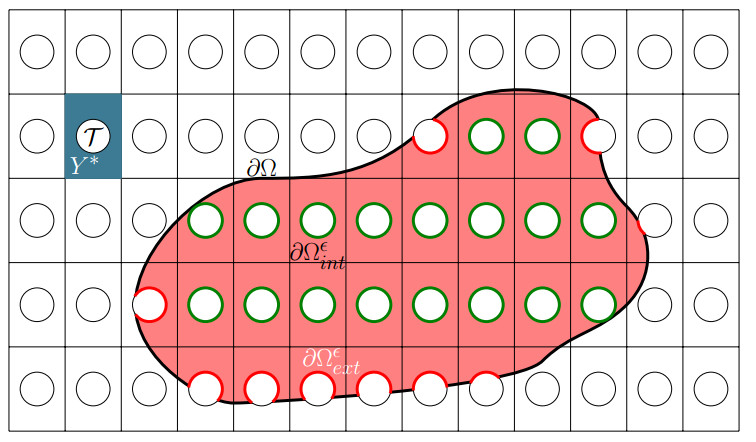









 DownLoad:
DownLoad:


